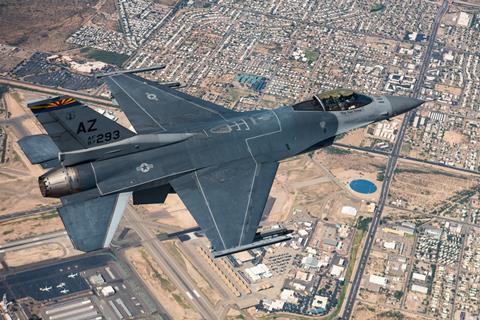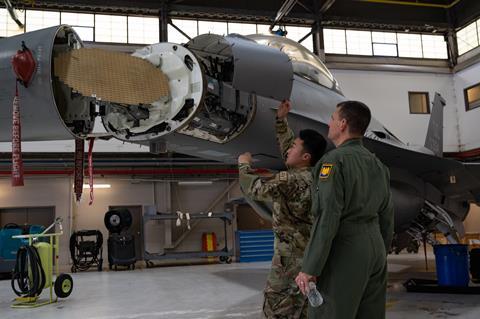The US Air Force (USAF) has ordered an additional 54 air combat radar systems as part of the service’s bid to modernise its fleet of Lockheed Martin F-16 fighters.
The Air Force Life Cycle Management Center on 28 March disclosed a contract with Northrop Grumman for 54 active electronically scanned array (AESA) radars.

The deal is worth $128 million to Northrop, and follows a November 220 order for 45 radars of the type. The total F-16 AESA procurement is now valued at some $1.4 billion for Northrop.
The backlog on F-16 AESA deliveries now extends out to 2031, according to the USAF. Some 608 F-16s, from Block 40 and Block 50 airframes, are covered under the modernisation effort.
The advanced radar allows pilots to “detect, target, identify, and engage across a spectrum of threats at longer ranges and react with greater precision”, the USAF says.
An AESA array substantially increases the combat power of the aircraft, compared to the previous APG-68 fire control radar.
“With the AESA radar… I can target more things than I can shoot,” says Lieutenant Colonel Michael Trujillo, an F-16 pilot with the Washington DC Air National Guard.
Trujillo notes the previous radar system was “completely saturated” after acquiring two targets.
The USAF in early 2022 announced a massive effort to upgrade is F-16 fleet, known as the Post Block Integration Team (PoBIT). The project involves six USAF commands, 18 bases, multiple companies and contracts worth $6.3 billion.
In addition to AESA radars, PoBIT updates include a new mission computer, modernised cockpit, improved networking capability, new electronic warfare capability, a communications suite upgrade and a new centre display unit.
The service notes that the AESA radar and other upgrades “revitalises” the older F-16 type and allows such legacy aircraft to better integrate with the newer fifth-generation types like the Lockheed F-35 and F-22.
“This effort is a big deal for the [USAF],” says Oryan Joseph, programme manager with the Air Force Life Cycle Management Center. “In order for us to keep the F-16 in the fight performing all its different roles for our combatant commanders, we must significantly modernise the fleet.”
Despite first entering service in 1979, the single-engined fighter – first produced by General Dynamics and later Lockheed – remains widely popular around the world.

In fact, with an active fleet of 2,184 aircraft, the F-16 is the top active combat jet in the world, according to the 2023 FlightGlobal World Air Forces directory.
That represents a massive 15% of the world’s total combat aircraft fleet; more than double the nearest competitor: the Sukhoi Su-27 and its derivative types.
Lockheed has delivered F-16s to countries on all populated continents, including Bahrain, Chile, Egypt, Greece, Iraq, Israel, Morocco, New Zealand, Oman, Poland, Singapore, South Korea, Taiwan and the United Arab Emirates.
Demand for the type has proven so strong that Lockheed recently established a new final assembly line in Greenville, South Carolina to produce the F-16 in a V-model, or Block 70/72 standard.
The Royal Bahraini Air Force will have the distinction of taking the first jet off that line. The island country currently operates 21 F-16C/Ds and will purchase 16 new builds under a 2018 contract.
In addition to Bahrain, four other countries have so far signed firm contracts to acquire the Block 70 and Block 72 aircraft, with their combined commitments totalling 128 jets.
These buyers include, along with Bahrain, Morocco (24) and Taiwan (66), plus two future new operators: NATO members Bulgaria (8) and Slovakia (14).
Additional reporting by Craig Hoyle and Greg Waldron














































